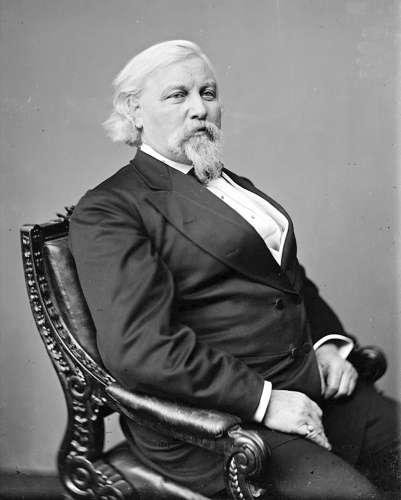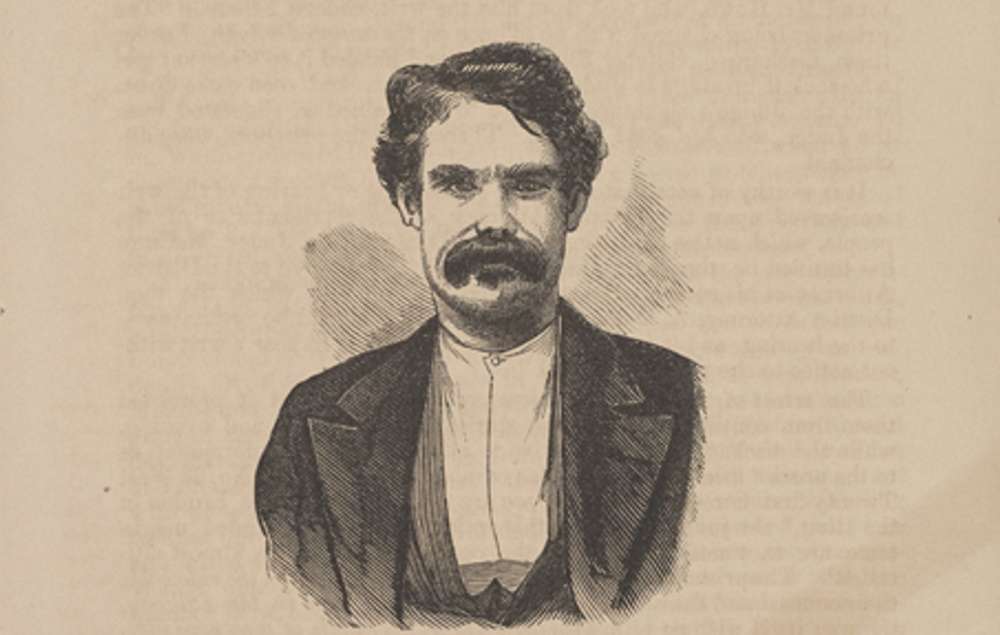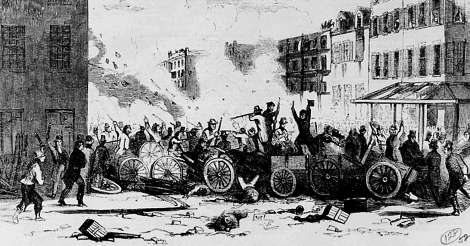There are the Hollywood Bowery Boys of the movies – who morphed from gritty city slum dwellers to whimsical scamps on the big screen. Then there are the real Bowery Boys of the middle 1840s and 50s, anti-Catholic thugs of the Know-Nothing movement. Reddy the Blacksmith was one of them.
Though these Bowery Boys were largely working class men who formed a society around their volunteer fire company, they also dabbled in a wide variety of crime. In 1857 they engaged with another gang, the Dead Rabbits, in a three day gang war that terrorized New York City.
The Bowery Boys were street brawlers, barroom thugs, gamblers and thieves who outfitted themselves in red shirts, black pants, leather boots and stove-pipe hats. They provided their chosen New York politicians an army of “repeaters” – men who would register and vote in multiple city neighborhoods to bring home the wins for the corrupt politicians. And they liked prizefighting.
Illicit Action
Just after dark on the night of February 11, 1867, a train pulled into New Haven station carrying a load of these New York toughs. They went to one of the city’s darkest and dirtiest streets and joined up with boxer Billy Warburton.
From there they sneaked off into the dark, heading toward nearby Milford. In this small town, Warburton and Horatio Bolster, a local Waterbury, Conn., fighter were to square off. The New York Tribune sent a reporter along to shadow the illicit action as the crowd set up a makeshift ring on a level field along the banks of the Housatonic River.

“The Yale students, the gamblers, thieves, pickpockets, fighters and others all crowd up to the ropes, and men in very loud attire from Houston Street, and the contiguous faro banks begin to offer bets in a very noisy manner,” he reported. All night long the carousing continued.
Around nine o’clock on the morning of the 12th, Warburton tossed his fur hat into the ring. Literally tossing a hat in the ring was a challenge that a man was willing to fight. At about 10 o’clock with the crowd swelled, Bolster threw his hat in, and the fight was set.
Warburton was the taller and heavier of the two men. Bolster appeared so drunk he could hardly stand up straight. The odds heavily favored Warburton as the fight started. The fight was not governed by the Marquis of Queensbury Rules. Rather, the bare-knuckled fighters could butt heads, gouge eyes and otherwise freelance. The fight could go on for as many rounds as both men wanted. Rules were few, though you could not hit an opponent when he was down.
Disgusting and Beastly
Bolster employed a strange but clever strategy. He would take two or three punches from Warburton, then flop to the ground, apparently smiling.
After five rounds of this, Warburton’s temper got the best of him. In the sixth round, Bolster flopped and Warburton pursued him, landing several punches while the smaller man lay on the ground. Warburton was disqualified. The decision enraged the crowd, which expected to see at least a dozen rounds of fighting.
By the time the crowds left Milford, the toughs had terrorized the little village. A free-for-all broke loose, tumbling its way through town. The crowd smashed windows and destroyed fences. An impromptu match was finally arranged at the railroad tracks between a man from Connecticut and another from Rhode Island named Breeney and Arnold.
“They fought up and down the enclosed track in the most disgusting and beastly manner, for a space of twenty minutes, chawing, biting and gouging each other without molestation or interference from the delighted crowd. Breeney had his upper lip and part of his nose eaten off and his head nearly kicked to pieces, and when our reporter left the depot at the Junction, Arnold was upon the platform of the signal station, lying unconscious and unheeded as any dog, bleaching in the sun, while three of the country police stood at a distance of about 20 feet calmly whittling sticks and debating whether they should or should not arrest the reporter who was present.”
Time for the Cops
The town of Milford was outraged. Town officials got ready for any repeat and hired professional police officers. In 1869, prizefighting popped up again in Mystic. On the train ride home this time the Bowery Boys took control of the train and robbed the passengers.
Now the state realized the prize fight promoters were playing hide and seek. The governor and police kept their ear to the ground and waited for 1870. They learned that the Bowery Boys intended another trip to Connecticut. The gang planned to come back to Milford’s Charles Island. This time, however, the state would be ready.
The fight in 1870 was to be between Edward Touhey and James Kerrigan on April 13. Touhey was from Brooklyn and Kerrigan from New York City.
Reddy the Blacksmith
Reddy the Blacksmith organized the fight. Born in Liverpool to Irish parents, his real name was William Varley. In New York, he belonged to the Bowery Boys gang, (though presumably after the gang dropped its anti-Catholicism.
His nickname came from his red hair and his training as a blacksmith, and he reportedly used his blacksmithing skills to craft burglary tools. During his short life, Reddy became something of a criminal legend in New York. He owned a small grocery and a saloon on Broadway at Houston Street.
He was a brawler, a killer, and a gambler who controlled much of the criminal activity in New York’s Bowery District around 1870. Reddy had a long record of arrests. Since his arrival in New York in 1848 at age 13, he killed three men, each time escaping with a plea of self-defense. One election day he had been arrested with 15 property tax bills in his pocket, each with a different address – he had planned to vote 15 times.
Once he robbed a man and fled to California to wait while his victim could be persuaded to change his story. He was caught because he helped free a woman from a train compartment whose lock had gotten jammed. Watching him smoothly work open the lock, the train security realized he had to be a professional thief, and they returned him to New York. But by then, of course, his victim had changed his tune.
Reddy showed up in Connecticut to stage the Touhey-Kerrigan prize fight. But that night Governor Marshall Jewell would thwart him. Jewell, born in New Hampshire, was a businessman who ran a tannery that produced leather goods during the Civil War.
Charles Island
The public in Connecticut was disgusted by the prizefighters that invaded the state – seemingly without fear of punishment. Participating or organizing a prize fight could get you five years in jail. Attending one could get you two. Yet New York rogues had managed to slip into Connecticut, stage their fights, run roughshod over the local people and return to New York with impunity. Jewell would end that.
Touhey and his entourage left Brooklyn for Charles Island on a steamer – the Pope Catlin. Kerrigan made his way using a series of boats. In Bridgeport, the fight-goers got their first hint that there might be trouble as rumors spread that the police might put a stop to the fight.

Charles Island
The rumors were right.
While police were busy rounding up a hundred or so people at the fight scene on Charles Island, another group of fight fans boarded a train at Bridgeport hoping to return to New York. When the train hit Fairfield, however, it stopped for longer than usual at the station. Then the train’s locomotive uncoupled itself from the cars and pulled away.
The fight fans were puzzled. But not for long. Governor Jewell had dispatched the National Guard, which arrived in another train to arrest the fight fans at gun point. The jails filled filled with fighters, promoters, gamblers and pickpockets. The Pope Catlin, meanwhile, was impounded.
Keep Them
Learning that Reddy Blacksmith & Co. were in jail in Connecticut, the New York Sun ran the headline: “Keep Them, Connecticut.” But Reddy’s friends had already bailed him out and returned him home.
Reddy actually made one other “raid” on Connecticut in 1871 — a political raid. The Bowery Boys had a reputation for breaking up polls, smashing ballot boxes and otherwise disrupting New York City elections.

Marshall Jewell
In the fall of 1871, Gov. Marshall Jewell faked a telegraph from his opponent, James English. It made it look like English planned to bring the Bowery Boys to Connecticut to disrupt the voting and ensure a win for English. He got the press to publicize the story. The Sunday before the voting, Jewell managed to have an intermediary pay to bring Reddy he Blacksmith and his gangs into Connecticut. He wanted to validate the story and galvanize his supporters to come out and vote. He emerged with a win.
Reddy the Blacksmith had to close up his saloon in 1875. Bright ’s Disease of the kidneys had slowed him and he died within the year.
Images: Charles Island By Randal J. (RJFerret) – Self-photographed, CC BY-SA 2.5, https://commons.wikimedia.org/w/index.php?curid=6010467. Reddy the Blacksmith <ref name=NYPL>{{cite web | url=https://digitalcollections.nypl.org/items/a6138e40-93e8-0130-3813-58d385a7bbd0 | title= (still image) William Varley, alias “Reddy the Blacksmith.” Pickpocket, thief and Democratic “regulator.” (See appendix.), (1869) |author=Digital Collections, The New York Public Library |accessdate=March 28, 2022 |publisher=The New York Public Library, Astor, Lenox, and Tilden Foundations}}</ref>. Riot By Illus. in: Frank Leslie's illustrated newspaper, v. 4, (1857 July 18), p. 108. – Call number: Illus. in AP2.L52 1857 (Case Y) [P&P]Reproduction Number: LC-USZ62-121644 (b&w film copy neg.)Library of Congress Prints and Photographs Division Washington, D.C. 20540 USA [1], Public Domain, https://commons.wikimedia.org/w/index.php?curid=605475.


2 comments
[…] The island also was cursed twice more. Once by the pirate William Kidd, who buried stolen treasure there in 1699 that was dug up by authorities who arrested him. Kidd cursed anyone who took his treasure. And it was cursed once more by a group of five sailors who used the island to hide gold that they had stolen from Mexican emperor Guatmozin. He cursed the thieves who took his gold and the gold, as well. […]
[…] Prizefights were illegal in 1853, but that didn’t stop Irish immigrant gangs in New York City from roughing each other up. […]
Comments are closed.